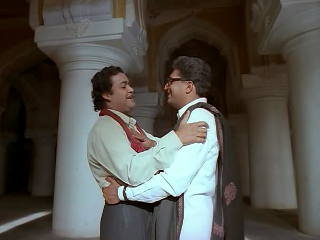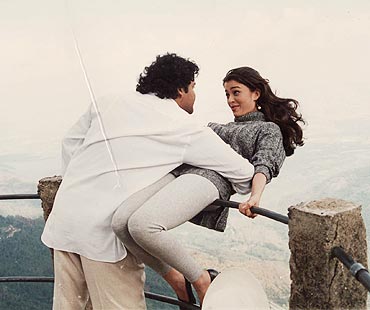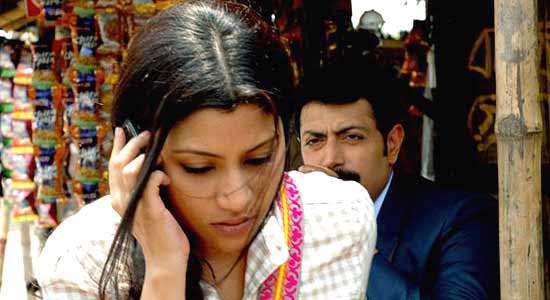For all the controversies that marred the Adoor Gopalakrishnan Committee, delegates at this year's edition of the International Film Festival of Kerala were almost unanimous in their appreciation for the package presented this year. This time around, I had a lot more time in my hands, and feasted my eyes on more than a dozen movies, including some featured in the competition. So I do have a lot to write about, though I won't be writing about all of them; just the ones that made the best impression on me.
Of the films I saw in the competition section, the one that impressed me the most was They are the Dogs, a Moroccan-French co-production written and directed by Hicham Lasri. Set in 2011 during the Arab Spring in Casablanca, the film revolves around a TV news reporter and his crew who stumble upon an old man out of prison after he was arrested in the 1981 Casablanca uprising. Thirty years on, the man has slightly lost his mental balance, can't remember his name (he identifies himself with the number 404), and wants to reunite with his wife and son. The reporter, who smells a good story, follows him along with his crew.
With much humour and irony, They are the Dogs, through the senile old man (played admirably by Hassan Badida), reflects on the harsh political conditions in Morocco, and we see the film as recorded by the TV news camera. The almost cinéma vérité approach makes the camera a participant in the narrative, and the object of people's ire as an unwanted intrusion; even the news reporter and his crew are subject to the same treatment. But the comically exaggerated reactions of people towards the camera brings home the truth that what we are watching is no documentary. By employing the cinema verite aesthetic to craft a work of conscious artifice, director Lasri subverts its very purpose.
Seven-year-old Matias (Sebastian Molinaro) and his pregnant mother Laura (Julieta Diaz) flee his abusive father in search of a safer abode in the Argentinian Refugiado, winner of the best film award. The Diego Lerman-directed drama follows the mother-son duo as they move from women's shelter to hotel and a brothel before finally arriving at Laura's childhood home, where her mother stays. Her husband, Fabian, is never seen in the film, but he remains a constant presence through his relentless phone calls.
Director Lerman presents the story as little Matias sees it, and it is mostly through his point of view that the story develops, giving several sequences a childlike naivete. Especially memorable is the
episode where Matias befriends another little girl about his age in the
women's shelter until he has to leave with his mother. But there are moments when the film shifts to Laura's point of view, especially when Matias locks himself up in the bathroom demanding that he take all his toys as they prepare to desert their home, with Fabian close on their heels. The film features gripping performances from the lead pair of mother and son, along with impressive cinematography by Wojciech Staron, and the final sequence of the boy running into the woods somehow seemed to remind me of Truffaut's 400 Blows.
Less impressed I was with the Japanese Summer, Kyoto, which won Hiroshi Toda the best direction prize. In it, an aging couple make their living by selling scented bags, until one evening the husband brings home a man he had found lying unconscious outside. The next morning, the stranger, feeling better, expresses his gratitude by offering to deliver the day's consignment of scented bags. But when he fails to turn up with the money after dusk, the couple grow anxious. If the film's theme seemed like a pretentious parable, its stylistics smacked of Ozu to me.
Another film I found remarkable was Hill of Freedom by the South Korean director Hong Sang-soo, a romantic comedy featured in the World Cinema section. Kwon (Seo Young-hwa), a teacher at a language school in Seoul, receives a bunch of letters Mori (Ryo Kase),
a Japanese teacher whose proposal she had rejected and who had come
over to the capital city to meet her during her absence, and written a
string of letters to her. The letters being undated and mixed up after
they were dropped by Kwon, give us an account of Mori's stay in Seoul in
non-chronological order, in the order in which Kwon reads them, and we
come across such characters as Sangwon
(Kim Eui-sung), his landlady's nephew, and Youngsun (Moon Sori), who
runs a cafe that bears the film's title, and with whom Mori develops a
relationship.
Being a cross-culture film, it seems only natural that most of the dialogues are in English. The director uses the opportunity to poke gentle fun at the superficial internationalism of present-day urban youth, which is in large part derived from American popular culture. Especially amusing are the conversations in English, which seldom go beyond fake pleasantries and the most banal of exchanges. While the fragmented narrative and single-take coverage of scenes are innovations that are as old as cinema itself, director Hong-sang Soo's cleverly written script gives the film its originality, backed by a brilliantly deadpan performance from lead actor Ryo Kase, who played the menacing boyfriend in Kiarostami's Like Someone in Love, which I had seen and written about two years back here.
However, my discovery of 2014 was the Hungarian director Miklos Jancso, whose work was presented in a retrospective here. Having only read about the master, who died earlier this year, in film writings, I knew what to expect.
Paying not the slightest obeisance to the rules of narrative cinema, Jancso's films, often dealing with Hungarian history and politics, take the form of highly stylised ballets and are filmed in takes that go on for minutes without a cut, employing complex camera movements. In total, a Jancso feature, which could have a running time of anywhere between 70-90 minutes, may not have more than 30 shots. While I could not read into the elaborately choreographed ballets (given my ignorance of Hungarian history or her politics or ballet dancing), the qualities that struck me were his style. I had known and admired the work of several long-take masters like Renoir, Mizoguchi, and Welles, but Jancso's use of the long take seemed strikingly original.
I managed to catch Silence and Cry (1968) and Red Psalm (1971) in decent, occasionally scratchy, 35mm prints. The former film told the story of a revolutionary who goes into hiding in the country after the failed Hungarian uprising of 1919. While the film was a more straightforward narrative with no ballets or songs, it did feature his long takes. Red Psalm, on the other hand, dealt with a peasant uprising in 1890, featured the very qualities of Jancso's work mentioned above, and won the best direction prize at the 1972 Cannes Film Festival. While the print of Red Psalm, shot in colour, had faded to pink, Silence and Cry, in black-and-white, were beautiful in the portions without scratches, more beautiful than any digital projection could dream of.
The other rewarding experience at this festival was the opportunity to watch Buster Keaton, also in retrospective. Though I had seen the great silent comedian's work on laptop and on TV, nothing really compares to the experience of watching silent comedy on a 25ft screen, in the dimensions they were originally designed to be seen. I couldn't watch The General (1927), arguably his greatest film, which was screened before I could make it there, though I would have given anything (except my job) to watch it on the big screen. But I did manage to catch the marvellous Sherlock Jr. (1924). While the celebrated sequence where Buster, working as movie projectionist, enters the movie screen remains its biggest eye-grabber, the other gags from the film were no less astounding, and was the film greeted with applause that could match that of any film presented this year. Not bad, for a film made nine decades earlier.
Seven Chances (1925), however, was a disappointment, not merely for its unremarkable plot, but more for its blatant racism towards African-Americans, and the gags directed at them seemed to me in poor taste, and especially unfortunate for an artist like Keaton. But this retrospective has had me looking forward to more opportunities to catch silent cinema, especially silent comedy, projected on a 25ft screen.
I ended my brief (but longer than usual) stay at this year's festival with Mohsen Makhmalbaf's President, made in Georgia. The Iranian director-in-exile, much affected by the Arab Spring and other uprisings against dictatorships, resorts to a political parable here, as a dictator of an unnamed country witnesses an revolution that topples his government. Generally referred to as President and addressed as Your Majesty by his grandson, the military also turns against him, forcing him and his grandson try to flee in disguise to the neighbouring country, where the rest of his family are. What begins as a lightly comic take gradually transforms into high-octane drama, as in their attempts to conceal their true identities, the dethroned ruler and his grandson find themselves witnesses to the suffering inflicted by his brutal regime, and the widespread turmoil that revolution has caused.
While it is a given that dictatorships are ruthless and uprisings were only to be expected, Makhmalbaf refuses to side with any group. While he lampoons the vanity of the dictator and his family, he is seldom demonised. While the suffering he inflicted on his subjects prior to the revolution is often referred to, Makhmalbaf reminds us of the general state of anarchy and opportunism that accompanies an uprising, and often questions the legitimacy of violent revolution. Towards the end, Makhmalbaf turns his camera away from what would seem like the film's tragic outcome to a shot of the dictator's grandson, as he erupts into a dance for democracy.
While the film risks seeming simplistic in its attempts to be universal, I still find it one of the most compelling films I've seen in a long time. Makhmalbaf narrates his story with such ease without the slightest self-conscious attempt at cinematic bravura, and the transition in tone from the comic to the dramatic so seamless, that you realise you are watching the work of one of the finest directors today.
So that's that for now. See you until my next post.
 |
| They are the dogs |
With much humour and irony, They are the Dogs, through the senile old man (played admirably by Hassan Badida), reflects on the harsh political conditions in Morocco, and we see the film as recorded by the TV news camera. The almost cinéma vérité approach makes the camera a participant in the narrative, and the object of people's ire as an unwanted intrusion; even the news reporter and his crew are subject to the same treatment. But the comically exaggerated reactions of people towards the camera brings home the truth that what we are watching is no documentary. By employing the cinema verite aesthetic to craft a work of conscious artifice, director Lasri subverts its very purpose.
Seven-year-old Matias (Sebastian Molinaro) and his pregnant mother Laura (Julieta Diaz) flee his abusive father in search of a safer abode in the Argentinian Refugiado, winner of the best film award. The Diego Lerman-directed drama follows the mother-son duo as they move from women's shelter to hotel and a brothel before finally arriving at Laura's childhood home, where her mother stays. Her husband, Fabian, is never seen in the film, but he remains a constant presence through his relentless phone calls.
 |
| Refugiado |
Less impressed I was with the Japanese Summer, Kyoto, which won Hiroshi Toda the best direction prize. In it, an aging couple make their living by selling scented bags, until one evening the husband brings home a man he had found lying unconscious outside. The next morning, the stranger, feeling better, expresses his gratitude by offering to deliver the day's consignment of scented bags. But when he fails to turn up with the money after dusk, the couple grow anxious. If the film's theme seemed like a pretentious parable, its stylistics smacked of Ozu to me.
 |
| Hill of Freedom |
Being a cross-culture film, it seems only natural that most of the dialogues are in English. The director uses the opportunity to poke gentle fun at the superficial internationalism of present-day urban youth, which is in large part derived from American popular culture. Especially amusing are the conversations in English, which seldom go beyond fake pleasantries and the most banal of exchanges. While the fragmented narrative and single-take coverage of scenes are innovations that are as old as cinema itself, director Hong-sang Soo's cleverly written script gives the film its originality, backed by a brilliantly deadpan performance from lead actor Ryo Kase, who played the menacing boyfriend in Kiarostami's Like Someone in Love, which I had seen and written about two years back here.
 |
| Miklos Jancso |
Paying not the slightest obeisance to the rules of narrative cinema, Jancso's films, often dealing with Hungarian history and politics, take the form of highly stylised ballets and are filmed in takes that go on for minutes without a cut, employing complex camera movements. In total, a Jancso feature, which could have a running time of anywhere between 70-90 minutes, may not have more than 30 shots. While I could not read into the elaborately choreographed ballets (given my ignorance of Hungarian history or her politics or ballet dancing), the qualities that struck me were his style. I had known and admired the work of several long-take masters like Renoir, Mizoguchi, and Welles, but Jancso's use of the long take seemed strikingly original.
I managed to catch Silence and Cry (1968) and Red Psalm (1971) in decent, occasionally scratchy, 35mm prints. The former film told the story of a revolutionary who goes into hiding in the country after the failed Hungarian uprising of 1919. While the film was a more straightforward narrative with no ballets or songs, it did feature his long takes. Red Psalm, on the other hand, dealt with a peasant uprising in 1890, featured the very qualities of Jancso's work mentioned above, and won the best direction prize at the 1972 Cannes Film Festival. While the print of Red Psalm, shot in colour, had faded to pink, Silence and Cry, in black-and-white, were beautiful in the portions without scratches, more beautiful than any digital projection could dream of.
 |
| Buster Keaton |
Seven Chances (1925), however, was a disappointment, not merely for its unremarkable plot, but more for its blatant racism towards African-Americans, and the gags directed at them seemed to me in poor taste, and especially unfortunate for an artist like Keaton. But this retrospective has had me looking forward to more opportunities to catch silent cinema, especially silent comedy, projected on a 25ft screen.
I ended my brief (but longer than usual) stay at this year's festival with Mohsen Makhmalbaf's President, made in Georgia. The Iranian director-in-exile, much affected by the Arab Spring and other uprisings against dictatorships, resorts to a political parable here, as a dictator of an unnamed country witnesses an revolution that topples his government. Generally referred to as President and addressed as Your Majesty by his grandson, the military also turns against him, forcing him and his grandson try to flee in disguise to the neighbouring country, where the rest of his family are. What begins as a lightly comic take gradually transforms into high-octane drama, as in their attempts to conceal their true identities, the dethroned ruler and his grandson find themselves witnesses to the suffering inflicted by his brutal regime, and the widespread turmoil that revolution has caused.
 |
| President |
While the film risks seeming simplistic in its attempts to be universal, I still find it one of the most compelling films I've seen in a long time. Makhmalbaf narrates his story with such ease without the slightest self-conscious attempt at cinematic bravura, and the transition in tone from the comic to the dramatic so seamless, that you realise you are watching the work of one of the finest directors today.
So that's that for now. See you until my next post.


















